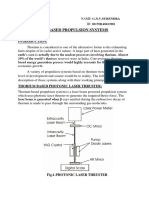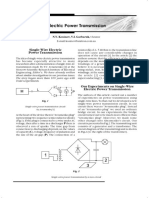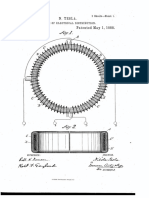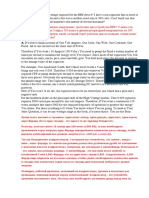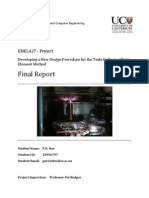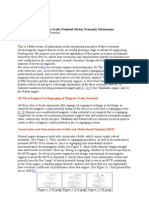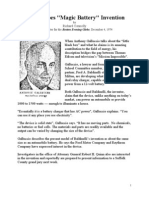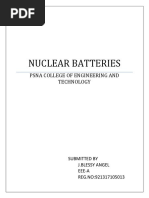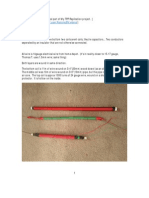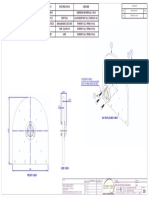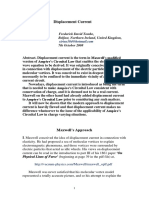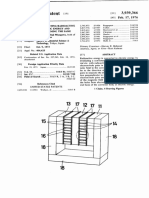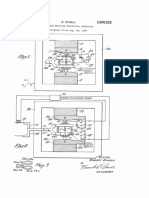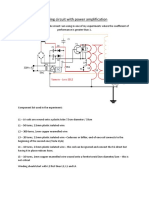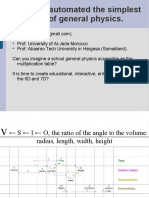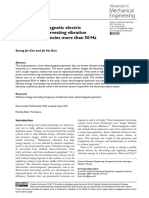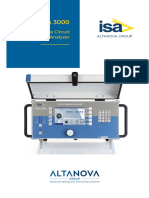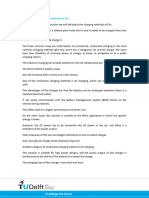0 ratings0% found this document useful (0 votes)
156 viewsUs4835433 PDF
Us4835433 PDF
Uploaded by
Anton DremlyugaThis patent describes a nuclear battery that directly converts radioactive decay energy into electrical energy. It utilizes the energy imparted to radioactive decay products to sustain and amplify oscillations in a high-Q LC tank circuit. The circuit inductance comprises a coil wound on a core made of a mixture of three radioactive materials that decay primarily by alpha emission. This provides a greater flux of decay products than an equivalent amount of a single radioactive nuclide and allows the system to generate electrical power for applications requiring larger power sources.
Copyright:
© All Rights Reserved
Available Formats
Download as PDF, TXT or read online from Scribd
Us4835433 PDF
Us4835433 PDF
Uploaded by
Anton Dremlyuga0 ratings0% found this document useful (0 votes)
156 views8 pagesThis patent describes a nuclear battery that directly converts radioactive decay energy into electrical energy. It utilizes the energy imparted to radioactive decay products to sustain and amplify oscillations in a high-Q LC tank circuit. The circuit inductance comprises a coil wound on a core made of a mixture of three radioactive materials that decay primarily by alpha emission. This provides a greater flux of decay products than an equivalent amount of a single radioactive nuclide and allows the system to generate electrical power for applications requiring larger power sources.
Original Title
US4835433.pdf
Copyright
© © All Rights Reserved
Available Formats
PDF, TXT or read online from Scribd
Share this document
Did you find this document useful?
Is this content inappropriate?
This patent describes a nuclear battery that directly converts radioactive decay energy into electrical energy. It utilizes the energy imparted to radioactive decay products to sustain and amplify oscillations in a high-Q LC tank circuit. The circuit inductance comprises a coil wound on a core made of a mixture of three radioactive materials that decay primarily by alpha emission. This provides a greater flux of decay products than an equivalent amount of a single radioactive nuclide and allows the system to generate electrical power for applications requiring larger power sources.
Copyright:
© All Rights Reserved
Available Formats
Download as PDF, TXT or read online from Scribd
Download as pdf or txt
0 ratings0% found this document useful (0 votes)
156 views8 pagesUs4835433 PDF
Us4835433 PDF
Uploaded by
Anton DremlyugaThis patent describes a nuclear battery that directly converts radioactive decay energy into electrical energy. It utilizes the energy imparted to radioactive decay products to sustain and amplify oscillations in a high-Q LC tank circuit. The circuit inductance comprises a coil wound on a core made of a mixture of three radioactive materials that decay primarily by alpha emission. This provides a greater flux of decay products than an equivalent amount of a single radioactive nuclide and allows the system to generate electrical power for applications requiring larger power sources.
Copyright:
© All Rights Reserved
Available Formats
Download as PDF, TXT or read online from Scribd
Download as pdf or txt
You are on page 1of 8
United States Patent (19) 11 Patent Number: 4,835,433
Brown (45) Date of Patent: May 30, 1989
54) APPARATUS FOR DIRECT CONVERSION 3,409,820 1 1/1968 Burke .................................. 3.10/305
OF RADIOACTIVE DECAY ENERGY TO 3,530,316 9/1970 Burke ... ... 310/30
ELECTRICAL ENERGY 3,562,613 2/1971. Adler ............ ... 310/304
3,939,366 2/1976 Ato et al. ...... ... 310/301
(75) Inventor: Paul M. Brown, Boise, Id. 3,944,438 3/1976 Hursen et al. ..... ... 136/202
4,489,269 12/1984 Edling et al. ....................... 376/320
73) Assignee: Nucell, Inc., Portland, Oreg.
(21) Appl. No.: 153,070 Primary Examiner-Deborah L. Kyle
Assistant Examiner-Daniel Wasil
22 Filed: Feb. 8, 1988 Attorney, Agent, or Firm-Leslie G. Murray
Related U.S. Application Data 57 ABSTRACT
63) Continuation of Ser. No. 855,607, Apr. 23, 1986, aban A nuclear battery in which the energy imparted to
doned. radioactive decay products during the spontaneous
disintegrations of radioactive material is utilized to sus
(51) Int. Cl." ............................................... G21H 1/00 tain and amplify the oscillations in a high-Q LC tank
(52) U.S. C. .................................... 310/305; 136/202; circuit is provided. The circuit inductance comprises a
376/320
58 Field of Search ................ 376/320, 321; 310/301, coil wound on a core composed of radioactive nuclides
310/304,305; 136/202 connected in series with the primary winding of a
power transformer. The core is fabricated from a mix
(56) References Cited ture of three radioactive materials which decay primar
U.S. PATENT DOCUMENTS ily by alpha emission and provides a greater flux of
2,548,225 4/1951 Linder ................................. 310/304
radioactive decay products than the equivalent amount
2,712,097 6/1955 Auwarter ..... ... 310/305 of a single radioactive nuclide.
2,739,283 3/1956 Roehrig ........ ... 310/301
3,290,522 12/1966 Ginell .................................. 310/305 10 Claims, 4 Drawing Sheets
U.S. Patent May 30, 1989 Sheet 1 of 4 4,835,433
U.S. Patent May 30, 1989 Sheet 3 of 4 4,835,433
4,835,433 2
1.
system, the conversion efficiency is very low and the
APPARATUS FOR DIRECT CONVERSION OF amount of electrical power provided too small for most
RADIOACTIVE DECAY ENERGY TO applications.
ELECTRICAL ENERGY U.S. Pat. No. 3,409,820 entitled "Electric Power
5 Appartus' issued to James O. Burke on Nov. 5, 1968,
CROSS REFERENCE TO RELATED discloses an amplification of an electric current by the
APPLICATION conduction of electric current through a radioactive
This is a continuation of application Ser. No. material. While providing some current amplification,
06/855,607, filed Apr. 23, 1986, now abandoned. 10 the system requires an external power source, such as a
BACKGROUND OF THE INVENTION conventional battery, and thus, cannot provide suffi
cient power for most applications.
The present invention relates generally to apparatus U.S. Pat. No. 3,939,366 entitled "Method of Convert
for the direct conversion of the energy of radioactive ing Radioactive Energy to Electric Energy and Device
decay products to electrical energy and, more particu 15 for Performing the Same' issued to Yasuro Ato et al. on
larly, to the utilization of an alpha source to sustain and Feb. 17, 1976, discloses an apparatus in which radioac
amplify oscillations in an LC oscillator circuit. tive energy is converted to electric energy by irradiat
A growing need exists today for small, compact, ing a semiconductor material with radioactive decay
reliable, lightweight and self-contained rugged power products to produce a number of electron-hole pairs in
supplies to provide electrical power in such applications the material. A magnetic field is applied across the semi
as electric automobiles, homes, industrial, agricultural, 20 conductor material in a direction perpendicular to the
recreational, remote monitoring systems and satellites.
The majority of today's satellites are powered by solar direction of diffusion of the electron-hole pairs and to
cells and conventional chemical batteries and require the direction of the applied magnetic field thus collect
only a small amount of power to operate. Radar, ad ing the electrons and the holes at electrodes provided
vanced communications satellites and, especially, high- 25 on the respective end faces of the semiconductor mate
technology weapons platforms will require much larger rial to produce an electric potential across the semicon
power sources than today's space power systems can ductor material. While the conversion efficiency of the
deliver. For the very high power applications, nuclear system disclosed by Ato et al. is considerally higher
reactors appear to be the answer. However, for the than that disclosed by either Burke or Ginell, the power
intermediate power range, 10 to 100 kilowatts (kw), the 30 output of the system is not great enough for applications
nuclear reactor presents formidable technical problems. such as electric automobiles or satellites.
Given today's efficiencies, it would require many acres
of solar panels to provide 100 kw. Similarly, enough SUMMARY OF THE INVENTION
chemical fuel to provide 100 kw for any significant The primary object of the present invention is to
period of time would be too heavy and bulky for practi-35 provide an apparatus for the direct conversion of the
cal use.
Heretofore, there have been known several methods energy of radioactive decay to electric energy.
for conversion of radioactive energy released during which Another object is to provide an electric power source
the decay of natural radioactive elements into electrical is small, compact, reliable, lightweight, self-con
energy. A grapefruit-sized radioisotope thermo-electric 40 tained and rugged and therefore adaptable for use in
generator that utilized the heat produced from alpha automobiles, homes, industrial, agricultural and recre
particles emmitted as plutonium-238 decays was devel ational applications and satellites.
oped during the early 1950's. However, the power out Still another object is to provide an electric power
put was limited to a few hundred watts. Other methods source capable of providing large amounts of power for
converting the energy of radioactive decay directly into 45 long periods of time with little or no maintenance or
electrical energy are disclosed in U.S. Pat. Nos. refueling required.
3,290,522; 3,409,820; and 3,939,366. In accordance with the principles of the present in
U.S. Pat. No. 3,290,522 entitled "Nuclear Emission vention, a nuclear battery in which the energy imparted
Electrical Generator' issued to Robert Ginell on Dec. to radioactive decay products during the spontaneous
6, 1966, discloses apparatus which provides electrical 50 disintegrations of radioactive material is utilized to sus
power by modulating the density of a cloud of charged tain and amplify the oscillations in a high-Q LC tank
particles confined within an enclosed space by a mag circuit is provided. The inductance in the tank circuit
netic field. A radioactive material is positioned at the
center of an enclosing hollow sphere having its inner comprises the primary of a power transformer and is
surface coated with silver. The sphere is centrally posi- 55 tive materials.aAcore
wound about composed of a mixture of radioac
mixture of radioactive materials pro
tioned between the poles of a permanent magnet. The duces a greater flux of radioactive decay products than
variation in the density of the cloud of charged particles the use of a single radioactive material by itself pro
causes a variation in the magnetic field created by the duces thereby providing the necessary flux
cloud. This variation in the magnetic field cuts an elec power output from a small core volume. Usefor of
large
long
trically conductive means to create an electrical poten- 60 lived isotopes, such as radium, ensures that the nuclear
tial and current therein. The density of the cloud of
charged particles may be varied by applying a periodi battery will have a constant output for at least ten years.
cally varying electro-static or electro-magnetic field to BRIEF DESCRIPTION OF THE DRAWINGS
the confined cloud of charged particles. The electrical
energy is derived from the kinetic energy imparted to 65 Other and further objects and advantages of the pres
the charged particles (decay products) on the occur ent invention will be apparent from the following de
rence of a spontaneous disintegration event during the tailed description with reference to the accompanying
decay of the radioactive material. However, with this drawings in which
4,835,433
3 4.
FIG. 1 is a schematic diagram of an LC equivalent collide with one or more atoms in the conductor knock
resonant circuit according to the principles of the pres ing electrons from their orbits and imparting some ki
ent invention; netic energy to the electrons. This results in increased
FIG. 2 is a wiring diagram of a nuclear battery con numbers of conduction electrons in the conductor
structed according to the principles of the present in thereby increasing its conductivity.
vention; Since the alpha particle is a positively charged ion,
FIG. 3 is a plan view of the top of the radioactive while the alpha particle is moving it will have an associ
core of the nuclear battery shown in FIG. 2. ated magnetic field. When the alpha particle is stopped
FIG. 4 is a plan view of the top of the nuclear battery by the conductor, the magnetic field will collapse
shown in FIG. 2; and 10 thereby inducing a pulse of current in the conductor
FIG. 5 is a side view taken along the line A-A of the producing a net increase in the current flowing in the
nuclear battery shown in FIG. 3. circuit 1. Also, there will be additional electrons
DETAILED DESCRIPTION OF THE stripped from orbit due to ionization produced by the
PREFERRED EMBODIMENT positively charged alpha particles.
15 Referring now to FIG. 2, the nuclear battery 20 is
Referring now to FIG. 1, an equivalent electrical constructed in a cylindrical configuration. Inductor 5 is
circuit of a nuclear battery constructed according to the constructed of copper wire wound in a single layer
principles of the present invention is shown. An LCR around the radioactive core 7. Decay products, such as
circuit 1 is comprised of a capacitor 3, inductor 5, trans alpha particles, are emitted radially outward from the
former T primary winding 9 and resistance 11 con 20 core 7 as indicated by arrows 2 to be absorbed by the
nected in series. It is assumed that the electrical conduc copper conductor forming inductor 5. Eight transform
tors connecting the various circuit elements and form ers 15 are arranged in a circular pattern to form a cylin
ing the inductor 5 and primary winding 9 are perfect der concentric with and surrounding inductor 5. The
conductors; i.e., no DC resistance. Resistor 11 is a lump transformers 15 have primary windings 9a-9h con
resistance equivalent to the total DC resistance of the 25 nected in series which are then connected in series with
actual circuit components and conductors. The induc inductor 5 and capacitor 3 to form an LCR circuit. The
tor 5 is wound on a core 7 which is composed of a central core 7, inductor 5 and the eight transformers 15
mixture of radioactive elements decaying primarily by are positioned within a cylindrical-shaped container 19.
alpha particle emission. Copper wire is wound in a single layer on the outside
When current flows in an electrical circuit energy is 30 wall and the inside wall of cylinder 19 to form windings
dissipated or lost in the form of heat. Thus, when oscil 23 and 21 respectively. The transformers 15 secondary
lations are induced in an LCR circuit, the oscillations windings 13a-13h and windings 21 and 23 are con
will gradually damp out due to the loss of energy in the nected in series to output terminals 25 and 27. The con
circuit unless energy is continuously added to the cir figuration of inductor 5 is designed to insure maximum
cuit to sustain the oscillations. In the LCR circuit 35 irradiation of the copper conductor by the radioactive
shown in Figure 1, a portion of the energy imparted to core source 7. The cylindrical configuration of the
the decay products, such as alpha particles, during the power transformer insures maximum transformer effi
radioactive decay of the materials making up inductor ciency with minimum magnetic flux leakage.
core 7 is introduced into the circuit 1 when the decay Referring now to FIG. 3, the radioactive core 7 com
products are absorbed by the conductor which forms prises a radium needle 39 surrounded by a cylinder of
inductor 5. Once oscillations have been induced in the powdered thorium 31 having a plurality of uranium
LCR circuit 1, the energy absorbed by inductor 5 from rods 33 positioned within the thorium 31. The pow
the radioactive decay of the core 7materials will sustain dered thorium 31 is contained by concentric cylinder
the oscillations as long as the amount of energy ab walls 35 and 37. The use of a mixture of these radioac
sorbed is equal to the amount of energy dissipated in the 45 tive materials for the core 7 produces a synergistic ef
ohmic resistance of the circuit 1. If the absorbed is fect in that a greater flux of alpha particles is produced
greater than the amount of energy lost through ohmic than by any one of the materials above due to additional
heating, the oscillations will be amplified. This excess induced disintegration events occuring.
energy can be delivered to a load 17 connected across Referring now to FIGS. 4 and 5, top and side views
the transformer T secondary winding 13. 50 of a nuclear battery constructed in accordance with the
The processes involved in the conversion of the en principles of the present invention is shown. The induc
ergy released by the spontaneous disintegration of a tor core 7 consists of radium needle 39 positioned longi
radioactive material into electrical energy are numerous tudinally in the center of a cylinder of powdered tho
and complex. Materials that are naturally radioactive rium 31. The powdered thorium 31 is contained by
decay by the emission of either an alpha particle or a 55 concentric cylinder walls 35 and 37 (a material such as
beta particle, and gamma rays may accompany either light cardboard may be utilized for this purpose). Induc
process. Radioactive materials that decay primarily by tor 5 is formed from two layers of American Wire Gage
alpha particle emission are preferred as the inductor (AWG) #8 copper wire, one layer 41 wound on the
core 7 material. Alpha particles are emitted with very inward facing wall 37 surrounding the radium needle 39
high speeds, on the order of 1.6X 107 meters per second 60 and the other layer 43 wound on the outside of wall 35
(m/s), and, consequently, have very high kinetic en thereby surrounding the powdered thorium 31 and
ergy. Alpha particles emitted when radium, for exam uranium rods 33. The inductor core 7 is 1 inches in
ple, decays are found to consist of two groups, those diameter and 6 inches long, with an overall diameter of
with a kinetic energy of 48.79X105 electron volts (ev) inches for inductor 5. The eight transformers 15 each
and those having an energy of 46.95X105 ev. This ki 65 have a core 45 of laminated silicon steel 3/4 inches
netic energy must be dissipated when the alpha particles square by 6 inches in length. The primary windings
are absorbed by the conductor forming inductor 5. 9a-9h each consist of four layers of AWG #18 copper
During the absorption process, each alpha particle will wire and the secondary windings 13a-13h each consist
4,835,433 6
5
of two layers of AWG #12 copper wire. The transform 2. Apparatus as in claim 1 wherein said core is com
ers 15 have an overall outside diameter of 1 inches. prised of at least two different radioactive materials.
The outer cylinder 19 is laminated silicon steel and an 3. Apparatus as in claim 2 wherein said radioactive
inner winding 21 of AWG #12 copper wire and an materials decay primarily by alpha particle emission.
outer winding 23 of AWG #12 copper wire. End plates 4. Apparatus as in claim 3 wherein said core is com
47 and 49 consisting of inch thick annular rings of prised of three radioactive materials.
laminated silicon steel having an inner diameter of 23 5. Apparatus as in claim 4 wherein said three radioac
inches and outer diameter of 43 inches are utilized to tive materials comprise radium, uranium and thorium.
6. Apparatus for converting the energy of radioactive
provide a low reluctance path to complete the magnetic 10 decay products to electrical energy, said apparatus
circuit as shown by dashed line 51. comprising:
When assembled, the nuclear battery is immersed in an electrical conductor wound on a core to form an
an oil-filled can (not shown) equipped with heat sinks inductor having a first inductance, said core being
(not shown) to provide the necessary cooling for the fabricated of radioactive material;
power transformer. The capacitor 3 used in the LCR 15 a capacitor having a predetermined capacitance C;
circuit is a high Q energy discharge resonant capacitor a plurality of transformers disposed in a generally
of the oil filled type. circular configuration to form a cylinder, said core
Using a one millicurie radium needle 39, 200grams of being disposed within said cylinder, the longitudi
uranium 33 and 100 grams of powdered thorium 31 in nal axis of said core being coincident with the lon
the configuration shown in FIGS. 2 and 3, at 86 kiloHz, 20 gitudinal axis of said cylinder, each of said plurality
a continuous output of 23 amperes at 400 volts into a of transformers having a primary winding and a
resistance load has been achieved. A configuration uti secondary winding, each of said plurality of pri
lizing additional radium needles 53, as shown in FIG.4, mary windings connected in series fashion with the
may be used to achieve higher power outputs. remaining primary windings, each of said plurality
While I have shown and described the preferred
25 of secondary windings connected in series fashion
with the remaining secondary windings, said series
embodiment of my invention, it will be apparent to connected secondary windings for coupling elec
those skilled in the art that this invention is not limited trical energy to a workload; and
to the specific structure described herein and that nu electrical conductor means for connecting said induc
merous changes and variations may be made therein 30 tor, said capacitor, said series-connected primary
without departing from the spirit of the invention or windings and a predetermined resistance R in a
exceeding the scope of the appended claims. series fashion to form a series LCR circuit wherein
I claim: electrical oscillations are induced, said electrical
1. Apparatus for converting radioactive energy to oscillations being sustained and amplified by the
electrical energy, said apparatus comprising: 35 energy transferred to said electrical conductor by
an electrical conductor wound on a core to form an the radioactive decay of said radioactive material.
inductor having a first inductance, said core being 7. Apparatus as in claim 6 wherein said core is com
of radioactive material; prised of at least two different radioactive materials.
a capacitor having a predetermined capacitance C; 8. Apparatus as in claim 7 wherein said series LCR
a transformer having a primary winding, a secondary circuit comprises an inductance L equivalent to the sum
of the inductances of said inductor and said series-con
winding and a transformer core, said primary nected primary windings, capacitance C and a resis
winding and said secondary winding wound on tance R equal to the total distributed DC resistance of
said transformer core, said primary winding having said LCR circuit.
a second inductance, said secondary winding for 45 9. Apparatus as in claim 8 further including an outer
coupling electrical energy to a workload; and cylinder enclosing said cylinder and having its longitu
electrical conductor means for connecting said induc dinal axis coincident with the longitudinal axis of said
tor, said capacitor and said primary winding in core, an inner winding disposed adjacent the inner sur
series fashion to form a series LCR circuit wherein face of said outer cylinder, an outer winding wound on
electrical oscillations are induced, said electrical 50 the outer surface of said outer cylinder, said inner and
oscillations being sustained and amplified by the outer windings connected in series fashion with said
energy transferred to said electrical conductor by series-connected secondary windings for coupling elec
the radioactive decay of said radioactive material, trical energy to a workload.
wherein L is the sum of said first inductance and 10. Apparatus as in claim 9 wherein said core is com
said second inductance and R is a predetermined 55 prised of a mixture ofk radium,
: sk
uranium,
t k
and thorium.
resistance.
60
65
You might also like
- VRIL-Compendium-Vol-8-And Ground Radio-1995 PDFDocument308 pagesVRIL-Compendium-Vol-8-And Ground Radio-1995 PDFAnton Dremlyuga100% (1)
- 2014 Keshe FilesDocument2 pages2014 Keshe FilesTruth Press MediaNo ratings yet
- Us 5149407Document24 pagesUs 5149407Tomas KriukelisNo ratings yet
- Circuits Resonance: Laguna State Polytechnic University Sta Cruz, LagunaDocument14 pagesCircuits Resonance: Laguna State Polytechnic University Sta Cruz, Lagunasherina rebongNo ratings yet
- Thorium Based Propulsion Systems: Name: G.N.V.Surendra ID: 2017H1480139HDocument2 pagesThorium Based Propulsion Systems: Name: G.N.V.Surendra ID: 2017H1480139HNaga Venkata Surendra GannamaniNo ratings yet
- Nuclear BatteryDocument8 pagesNuclear Batteryకృష్ణ మురళిNo ratings yet
- Designs For Generating The Jeff Cook Effect: Dimension LaboratoriesDocument7 pagesDesigns For Generating The Jeff Cook Effect: Dimension LaboratoriesBilisuma ZewduNo ratings yet
- Single-Wire Electric Power Transmission: N.V. Kosinov, V.I. Garbaruk, UkraineDocument6 pagesSingle-Wire Electric Power Transmission: N.V. Kosinov, V.I. Garbaruk, UkraineDavide Tanner TainiNo ratings yet
- DR BL Pyramid Power PatentDocument3 pagesDR BL Pyramid Power PatentAni VinNo ratings yet
- Bedini 2Document4 pagesBedini 2EricNo ratings yet
- Positive and Negative Electricity. Free Energy Flywheel Electric Generator US20070120430 "Eternal Torch" or "Mini Fuel Free Generator"Document2 pagesPositive and Negative Electricity. Free Energy Flywheel Electric Generator US20070120430 "Eternal Torch" or "Mini Fuel Free Generator"Mihai DanielNo ratings yet
- Gray 4595975Document7 pagesGray 4595975MANNAJANELAGUNA0% (1)
- Patente Nicola Tesla US381970 PDFDocument5 pagesPatente Nicola Tesla US381970 PDFTomasMartinezArrietaNo ratings yet
- US9871431Document10 pagesUS9871431lianshengNo ratings yet
- Step Recovery DIODEDocument9 pagesStep Recovery DIODEwoyaoxiaxiaNo ratings yet
- United States: (12) Patent Application Publication (10) Pub. No.: US 2014/0253271 A1Document24 pagesUnited States: (12) Patent Application Publication (10) Pub. No.: US 2014/0253271 A1vali2daduica100% (1)
- CEM Without The Lorentz ConditionDocument5 pagesCEM Without The Lorentz ConditionmilousNo ratings yet
- DeLand Frost GuardDocument7 pagesDeLand Frost GuardAlexandru IsacNo ratings yet
- Pulse Charging Capacitors Through InductorsDocument5 pagesPulse Charging Capacitors Through InductorsJamtse GyatsoNo ratings yet
- Close Look at Charge Deposition From Pulsed Tesla Coil Hull + FusareDocument7 pagesClose Look at Charge Deposition From Pulsed Tesla Coil Hull + FusaremctyNo ratings yet
- Chapter 13Document61 pagesChapter 13Stevan FarkasNo ratings yet
- Forced Vortex ApparatusDocument4 pagesForced Vortex ApparatusgpradiptaNo ratings yet
- Antigravity KineticDocument33 pagesAntigravity KineticManojlovic VasoNo ratings yet
- Ответы Дона СмитаDocument5 pagesОтветы Дона СмитаVasily VorobyovNo ratings yet
- ENEL427 - Final Report - Pnr22 - Tesla CoilDocument19 pagesENEL427 - Final Report - Pnr22 - Tesla CoilPeter RueNo ratings yet
- REGAUGINGDocument5 pagesREGAUGINGaardsnailNo ratings yet
- 0102 - Forever Flasher PDFDocument3 pages0102 - Forever Flasher PDFMuhammadAsifNo ratings yet
- 2 Atoms and Over UnityDocument6 pages2 Atoms and Over UnityMad_Max_HJNo ratings yet
- Hieronymus Machine Construction Tips and Pitfalls To AvoidDocument6 pagesHieronymus Machine Construction Tips and Pitfalls To AvoidPetrut ValentinNo ratings yet
- Baldinelli ArticleDocument4 pagesBaldinelli ArticlepopoliberoNo ratings yet
- AssignmentDocument5 pagesAssignmentAbdul HannanNo ratings yet
- Tesla PaperDocument6 pagesTesla Paperapi-439426688No ratings yet
- Existence of Electromagnetic or Physical Vector Properties of Prime NumberDocument6 pagesExistence of Electromagnetic or Physical Vector Properties of Prime Number1357531No ratings yet
- Power Generation by Foot Step Method - Rack and PinionDocument13 pagesPower Generation by Foot Step Method - Rack and Pinionprem53100% (2)
- Understanding Magnets With EFD and SMPDocument16 pagesUnderstanding Magnets With EFD and SMPAnonymous Kti5jq5EJINo ratings yet
- #35 Electro Magnetic InductionDocument6 pages#35 Electro Magnetic InductionSang LeeNo ratings yet
- Nuclear Batteries: Psna College of Engineering and TechnologyDocument16 pagesNuclear Batteries: Psna College of Engineering and TechnologyDddddNo ratings yet
- Electric Motor: Your Activity MaterialDocument6 pagesElectric Motor: Your Activity MaterialJoel Varghese ThomasNo ratings yet
- LTseung PDFDocument71 pagesLTseung PDFMAGUS43No ratings yet
- Nuclear BatteryDocument26 pagesNuclear Batteryjoby jacobNo ratings yet
- C155 PDFDocument6 pagesC155 PDFtortbNo ratings yet
- US20140253271A1Document24 pagesUS20140253271A1Mihai Daniel100% (1)
- Bucking Coils Produce Energy Gain2Document6 pagesBucking Coils Produce Energy Gain2KONSTANTINOS TOMAZISNo ratings yet
- TPP Replication 1.0Document19 pagesTPP Replication 1.0Jim BuckeyneNo ratings yet
- Tesla Coil ProjectDocument58 pagesTesla Coil Projectvdahiya007No ratings yet
- дудышев новая эн 10-19 PDFDocument3 pagesдудышев новая эн 10-19 PDFAleksandrNo ratings yet
- Azerbajian Device Translated From RuslanDocument7 pagesAzerbajian Device Translated From RuslanbluesurviverNo ratings yet
- Experiment 6Document10 pagesExperiment 6Nfa Noorfadzilah MdisaNo ratings yet
- Weber-Type Laws of Action-at-a-Distance in Modern PhysicsDocument18 pagesWeber-Type Laws of Action-at-a-Distance in Modern PhysicsnirvicharaaNo ratings yet
- Correspondence 030706 - MaxwellDocument9 pagesCorrespondence 030706 - Maxwellgong688665No ratings yet
- The Theory of RelativityDocument2 pagesThe Theory of RelativityIlyass Chahoud100% (1)
- Iso Exploded View: Revisions Rev. Description Date 00 Original IssueDocument1 pageIso Exploded View: Revisions Rev. Description Date 00 Original IssueParpala BogdanNo ratings yet
- Steinmetz CP - Theory and Calculations of Electrical ApparatusDocument509 pagesSteinmetz CP - Theory and Calculations of Electrical ApparatusJe MaNo ratings yet
- Patent - Paul BabcockDocument25 pagesPatent - Paul BabcockHappyJoeNo ratings yet
- PerendevDocument7 pagesPerendevPopa IonelNo ratings yet
- Hybrid Tech Eat On Fuel CellDocument13 pagesHybrid Tech Eat On Fuel CellhhojonNo ratings yet
- Hydrogen in VacuumDocument27 pagesHydrogen in VacuumSiva SubramaniyanNo ratings yet
- Application of Flexible AC Transmission System Devices in Wind Energy Conversion SystemsFrom EverandApplication of Flexible AC Transmission System Devices in Wind Energy Conversion SystemsNo ratings yet
- Stanley Meyer Big Bobbin Builders Guide 2019 v1: Very Rare Guide for How to Assemble Water Fueled injector tri-filar bobbinFrom EverandStanley Meyer Big Bobbin Builders Guide 2019 v1: Very Rare Guide for How to Assemble Water Fueled injector tri-filar bobbinNo ratings yet
- Forum Di Episteme - F.D. TombeDocument23 pagesForum Di Episteme - F.D. TombeAnton DremlyugaNo ratings yet
- Displacement CurrentDocument5 pagesDisplacement CurrentAnton DremlyugaNo ratings yet
- Us4835433 PDFDocument8 pagesUs4835433 PDFAnton DremlyugaNo ratings yet
- Archimedes' Principle in The Electric SeaDocument4 pagesArchimedes' Principle in The Electric SeaAnton DremlyugaNo ratings yet
- Dual Space Theory PDFDocument2 pagesDual Space Theory PDFAnton DremlyugaNo ratings yet
- Ya, Zad: Nov. 5, 1968 J. O. Bur KE 3,409,820Document3 pagesYa, Zad: Nov. 5, 1968 J. O. Bur KE 3,409,820Anton DremlyugaNo ratings yet
- Us3939366 PDFDocument5 pagesUs3939366 PDFAnton DremlyugaNo ratings yet
- Sept. 22, 1970: Electric Power Methods and Apparatus Filed March L, 1968Document3 pagesSept. 22, 1970: Electric Power Methods and Apparatus Filed March L, 1968Anton DremlyugaNo ratings yet
- VRIL-Compendium-Vol-7-Dendritic Ground Systems-1992 PDFDocument204 pagesVRIL-Compendium-Vol-7-Dendritic Ground Systems-1992 PDFAnton Dremlyuga100% (3)
- Dec. 6, 1966 R, Gine 3,290,522: Original Filled Aug. 28, 1956Document6 pagesDec. 6, 1966 R, Gine 3,290,522: Original Filled Aug. 28, 1956Anton DremlyugaNo ratings yet
- Running circuit - РоиероDocument3 pagesRunning circuit - РоиероAnton DremlyugaNo ratings yet
- Underwater Electric Field Communication System: Filed April 10, 1962Document6 pagesUnderwater Electric Field Communication System: Filed April 10, 1962Anton DremlyugaNo ratings yet
- перевод - текст Вилберт СмитDocument8 pagesперевод - текст Вилберт СмитAnton DremlyugaNo ratings yet
- United States Patent (19) : Gilstrap, JRDocument5 pagesUnited States Patent (19) : Gilstrap, JRAnton DremlyugaNo ratings yet
- Algorithm Automated The Simplest Tasks of General PhysicsDocument35 pagesAlgorithm Automated The Simplest Tasks of General PhysicsAnton DremlyugaNo ratings yet
- United States Patent: GrimesDocument61 pagesUnited States Patent: GrimesAnton DremlyugaNo ratings yet
- Reduction of Binding ForceDocument5 pagesReduction of Binding ForceAnton DremlyugaNo ratings yet
- Bearing HeaterDocument5 pagesBearing HeaterAnand KatariyaNo ratings yet
- U.S. Pat. 9,514,727, Pickup With Integrated Contols, John Liptac, (Dialtone) Issued 2016.Document39 pagesU.S. Pat. 9,514,727, Pickup With Integrated Contols, John Liptac, (Dialtone) Issued 2016.Duane BlakeNo ratings yet
- Physics Project File TransformerDocument17 pagesPhysics Project File TransformerVedant AgnihotriNo ratings yet
- Important MCQ - Electrical Machine Design - WWW - Allexamreview.com - PDFDocument14 pagesImportant MCQ - Electrical Machine Design - WWW - Allexamreview.com - PDFlvb123No ratings yet
- Chapter 31 - Electromagnetic Oscillations and Alternating CurrentDocument20 pagesChapter 31 - Electromagnetic Oscillations and Alternating CurrentVV CepheiNo ratings yet
- Guide To ProtectionDocument32 pagesGuide To ProtectionpjaengjaikulNo ratings yet
- Wiring Diagram: Field Connections For Yk Chiller (Style G) Optiview Control Center With Remote Medium Voltage SssDocument12 pagesWiring Diagram: Field Connections For Yk Chiller (Style G) Optiview Control Center With Remote Medium Voltage SssAhmed GamalNo ratings yet
- Hardware: 2.1 Selection of MOSFETDocument16 pagesHardware: 2.1 Selection of MOSFETAmmar KhalidNo ratings yet
- Isolation Transformer Downstream of A UPS Causes Catastrophic DamageDocument15 pagesIsolation Transformer Downstream of A UPS Causes Catastrophic DamagePudeti RaghusreenivasNo ratings yet
- Linear Electromagnetic Electric Generator For HarvDocument9 pagesLinear Electromagnetic Electric Generator For Harvmohamed zakariaNo ratings yet
- CBA 3000 DatasheetDocument12 pagesCBA 3000 DatasheetAriNo ratings yet
- Introduction To TransformersDocument186 pagesIntroduction To TransformerscaplukNo ratings yet
- 3b .2 ServomechanismDocument9 pages3b .2 Servomechanismanbek_uNo ratings yet
- Final Thesis 150500Document45 pagesFinal Thesis 150500Arslan MushtaqNo ratings yet
- Specifications: Customer Item Model Name Part No DateDocument11 pagesSpecifications: Customer Item Model Name Part No Datejoroma58No ratings yet
- Quantum Energy Generator (QEG) - REVISED Manual Edition (March 2015)Document75 pagesQuantum Energy Generator (QEG) - REVISED Manual Edition (March 2015)FreeEnergyWorld100% (4)
- eCARS2x 2018 T3-1 Introduction Charging Methods EVs-1-4Document4 pageseCARS2x 2018 T3-1 Introduction Charging Methods EVs-1-4EulerNo ratings yet
- Bey Ma Enclosure Designs 2008Document91 pagesBey Ma Enclosure Designs 2008profiaudiofernando386No ratings yet
- IEC This Is An IncompleteDocument12 pagesIEC This Is An Incompleteassad alhawashemNo ratings yet
- Speed Limit Chapter 1Document21 pagesSpeed Limit Chapter 1kalu chimdiNo ratings yet
- Electrical Machines: IES Electrical Engineering Topic Wise QuestionsDocument78 pagesElectrical Machines: IES Electrical Engineering Topic Wise QuestionsahmedNo ratings yet
- BS en 9934-3Document21 pagesBS en 9934-3The Normal HeartNo ratings yet
- XI CS II Notes TerminalDocument22 pagesXI CS II Notes Terminaldigvijay maneNo ratings yet
- REPLICAS of MEYER by Hydrocars - WATER As FUEL - Review of Available Technologies - MDG 2006-2007Document19 pagesREPLICAS of MEYER by Hydrocars - WATER As FUEL - Review of Available Technologies - MDG 2006-2007Steve MolkeNo ratings yet
- Cambridge Ordinary LevelDocument16 pagesCambridge Ordinary LevelAayan AhmadNo ratings yet
- Manufacturing of TransformersDocument40 pagesManufacturing of TransformersSureshAgarwal100% (1)
- Harmonic Distortion in Power Stations Due To FerroresonanceDocument4 pagesHarmonic Distortion in Power Stations Due To FerroresonanceSunil KumarNo ratings yet
- Bowdens Hobby CircuitsDocument9 pagesBowdens Hobby CircuitsNaseer Hyden100% (1)
- Concepts For SSR v6Document37 pagesConcepts For SSR v6Awadhesh JaiswalNo ratings yet




